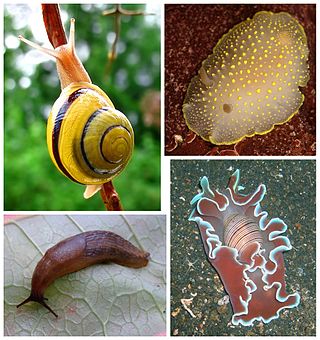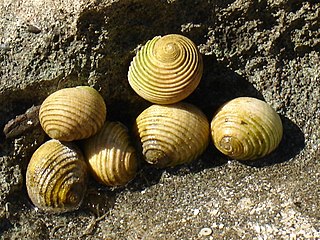Related Research Articles

Heterobranchia, the heterobranchs, is a taxonomic clade of snails and slugs, which includes marine, aquatic and terrestrial gastropod mollusks.

Pulmonata or pulmonates is an informal group of snails and slugs characterized by the ability to breathe air, by virtue of having a pallial lung instead of a gill, or gills. The group includes many land and freshwater families, and several marine families.

Caenogastropoda is a taxonomic subclass of molluscs in the class Gastropoda. It is a large diverse group which are mostly sea snails and other marine gastropod mollusks, but also includes some freshwater snails and some land snails. The subclass is the most diverse and ecologically successful of the gastropods.

Sorbeoconcha is a taxonomic clade of snails, i.e. gastropods, mainly marine species with gills and opercula, within the clade Caenogastropoda.

Stylommatophora is an order of air-breathing land snails and slugs, terrestrial pulmonate gastropod molluscs. This taxon includes most land snails and slugs. Stylommatophorans lack an operculum, but some close their shell apertures with temporary "operculum" (epiphragm) made of calcified mucus. They have two pairs of retractile tentacles, the upper pair of which bears eyes on the tentacle tips. All stylommatophorans are hermaphrodites.

Sea snail is a common name for slow-moving marine gastropod molluscs, usually with visible external shells, such as whelk or abalone. They share the taxonomic class Gastropoda with slugs, which are distinguished from snails primarily by the absence of a visible shell.

Neritopsoidea is a taxonomic grouping, a superfamily of sea snails, marine gastropod mollusks in the clade Cycloneritimorpha, within the clade Neritimorpha,, or in the order Neritoina within superorder Cycloneritimorpha within the subclass Neritimorpha,.

Pyramidelloidea is a superfamily of mostly very small sea snails, marine gastropod mollusks and micromollusks within the clade Panpulmonata.
Aillyidae is a family of air-breathing land snails, terrestrial pulmonate gastropod mollusks in the informal group Sigmurethra.

Lower Heterobranchia, also known as the Allogastropoda, is a group of rather specialized, highly evolved sea slugs and sea snails, within the subclass Heterobranchia.

Neritimorpha is a clade of gastropod molluscs that contains around 2,000 extant species of sea snails, limpets, freshwater snails, land snails and slugs. This clade used to be known as the superorder Neritopsina.

Sigmurethra is a taxonomic category of air-breathing land snails and slugs, terrestrial pulmonate gastropod molluscs. This is an informal group which includes most land snails and slugs.

Cycloneritida is an order of land snails, freshwater snails, and sea snails.

The Cerithioidea is a superfamily of marine, brackish water and freshwater gastropod containing more than 200 genera. The Cerithoidea are included unassigned in the subclass Caenogastropoda. The original name of this superfamily was Cerithiacea, in keeping with common superfamily endings at the time.

The Limacoidei is a taxonomic infraorder of air-breathing land snails, semislugs and slugs, terrestrial pulmonate gastropod molluscs in the suborder Helicina

Ampullarioidea is a taxonomic superfamily of freshwater snails, aquatic gastropod mollusks within the informal group Architaenioglossa, which belongs to the clade Caenogastropoda (unassigned).

Umbraculoidea is a superfamily of unusual false limpets with a thin soft patelliform shell, marine gastropod molluscs in the clade Umbraculida, within the clade Euopisthobranchia.
Runcinoidea is a taxonomic superfamily or a clade Runcinaecea of sea slugs, marine gastropod mollusks in the order Runcinida
This overview lists proposed changes in the taxonomy of gastropods at the family level and above since 2005, when the taxonomy of the Gastropoda by Bouchet & Rocroi (2005) was published. In other words, these are recent updates in the way various groups of snails and slugs are classified.

Rostellariidae is a family of sea snails, marine gastropod molluscs in the clade Littorinimorpha.
References
- ↑ Bouchet, Philippe; Rocroi, Jean-Pierre; Hausdorf, Bernhard; Kaim, Andrzej; Kano, Yasunori; Nützel, Alexander; Parkhaev, Pavel; Schrödl, Michael; Strong, Ellen E. (2017). "Revised Classification, Nomenclator and Typification of Gastropod and Monoplacophoran Families". Malacologia. 61 (1–2): 1–526. doi:10.4002/040.061.0201. S2CID 91051256.
- 1 2 Bouchet P., Rocroi J.-P., Frýda J., Hausdorf B., Ponder W., Valdés Á. & Warén A. (2005). "Classification and nomenclator of gastropod families". Malacologia: International Journal of Malacology. 47 (1–2). Hackenheim, Germany: ConchBooks: 1–397. ISBN 3925919724. ISSN 0076-2997.
{{cite journal}}: CS1 maint: multiple names: authors list (link) - ↑ WoRMS: Neomphalina
- Poppe, Guido T.; Tagaro, Sheila P. (23 February 2006). "The New Classification of Gastropods according to Bouchet & Rocroi, 2005" (PDF). Visaya. Archived from the original (PDF) on 29 July 2017. Retrieved 13 May 2018.